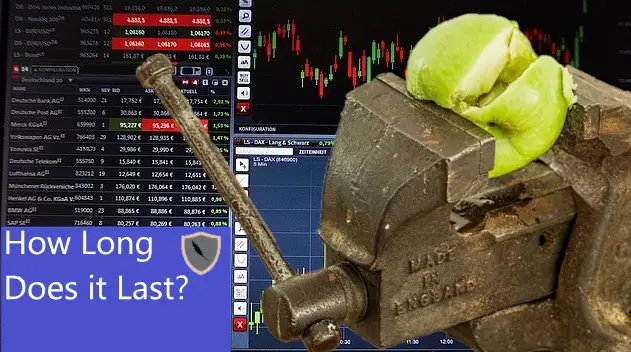Since 2012 the U.S market has been overvalued by nearly 200% when compared to traditional valuation metrics. This drastic increase in overvaluation has been caused by overvalued stocks impacting portfolios. Many investors and traders are unaware of how to make money using these overvalued stocks but once you understand the pros and cons it becomes easier.
The one main pro of an overvalued stock would be its ability to see massive price movement. However this pro is outweighed by two major cons; first being the difficulty in hedging a position and second a gradual increase in risk in the overvalued positions of your portfolio.
All overvalued stocks share one thing in common however, that is an increasing growth in implied volatility. This creates a spring-like effect that a good investor or trader can make money from.
Here at Chronohistoria I aim to publish the best investing articles on the web. I routinely publish articles that go over investment research, methodologies/strategies , and tips/tricks of the trade so that you are better prepared to earn in today’s crazy market.
Feel free to sign up for the free newsletter to remain up to date on all things investing.
Without further ado, here are the 3 pros and cons to know before investing in overvalued stocks.
What Exactly Is An Overvalued Stock
When analysts price a stock they forecast the stock’s current valuation. In order to do this the analyst must count up the company’s current assets and liabilities.
From this company valuation a prediction model is built called a Discounted Cash Flow. Within this DCF analysts predict that a company will either increase its assets or liabilities. From there the analyst can then divide the company’s current worth and future worth by the amount of shares on the market.
This is how companies are valued.
Now what happens when the company’s stock on the market is above analyst’s valuations? This means that for some reason the company is trading higher than its current worth.
This is called overvaluation. It happens because investors and traders on the stock market believe the company in the future will make more money and grow above the current price. As you might expect we can perform a calculation to see how much the market believes the stock will grow over time. This calculation is called a Price to Earnings ratio or P/E.
Since the 1990’s the average P/E on the U.S market has been exploding upwards. This means that the entire U.S stock market is overvalued to some degree.
The reason for this rapid explosion in P/E over 20 years is because of the growth of online retail traders using online trading software.
This massive influx of retail traders has caused the growth of the P/E ratio and thus the growth of overvalued stocks.
However this is no cause for alarm, good investors and traders earn millions from these overvalued stocks. The aim of this article is to go over the 3 pros and cons so that you know how to profit from this growing P/E ratio causing overvalued stocks.
Pro: Massive Price Movement
When a stock becomes overvalued anything can happen. This is because retail traders now dictate the stock’s price. For good traders and investors this is a massive pro in favor of overvalued stocks. It causes massive price movement.
The above image demonstrates this. In January of 2021 GameStop (GME) became massively overvalued. Analysts couldn’t explain why suddenly every single retail trader wanted to buy the stock.
However, the main pro of overvalued stocks is that now the professionals on the street can properly value. They are on the same playing field as retail traders and investors.
The only thing that you can be certain of in overvalued stocks is a growth in implied volatility. Eventually the overvalued stock will correct back down to its valuation or it will explode upwards. Think of this like a spring that is slowly coiling up to rapidly expand, either upwards or downwards.
There is an investment strategy where you can make money from either upwards or downwards price movement. It is called the Iron Condor and it involves strategically buying and selling options so that if a stock ever moves out of your determined range it will make you money.
As we can see from the above image if you set up an iron condor trade on the overvalued stock you will make money regardless if the stock goes up or down.
If you want to know how to properly execute the iron condor trading strategy you can read this article I wrote up on how to do it correctly.
Overvalued stocks always move. You don’t know if its up or down. That does not matter however since you can just open up an iron condor and make money regardless of direction.
Con: Hedging The Position Is Harder
Overvalued stocks by their definition cant be properly valued. Because of this they also can be hedged against properly.
When you hedge an investment you are taking out another position that will gain in the event that your primary investment fails. This in effect protects your portfolio from going down.
In a perfect world hedging an overvalued position would be easy. However since the overvalued stock is not based around sound valuations it also can be hedged against. This is because you don’t know what will move the stock so you can’t protect against it.
Not directly at least.
Hedging an overvalued stock is an artform. The more you do it the better it becomes. One of the easiest ways to hedge an overvalued stock is to open a position in an opposing currency.
For example, if your overvalued stock is based on the U.S exchange then it is impacted by the dollar. If the dollar fails then other currencies of the world will increase in value.
Other currencies of the world are based on the gold standard. As such a decent hedge would be simply buying a gold ETF.
There are many ways to properly hedge a portfolio or position. I wrote up an entire article on the 3 easiest ways you can hedge a position. If your interested in learning more than you can check out the article by clicking here.
Hedging an overvalued stock is a major con of investing in overvalued stocks. It becomes easier to do the more you practice but an overvalued stock always presents a challenge to even a seasoned investor.
Con: There Is Gradual Increase In Risk Overtime In Overvalued Stocks
Unlike other forms of investing, buying overvalued stocks can increase your risk over time.
Every single day you hold an overvalued position you run the risk of a price retracing back to normal levels. This creates risk in your portfolio.
The overvalued stock at any moment can return back to a normal market level. This is the theory behind the efficient market hypothesis theory. That all stock markets if left alone by investors will return to a proper valuation.
So far this theory has proved to be correct. As long as this continues then overvalued stocks should at some point in their future correct back down to their expected valuations.
However this often is not the case.
Over the past 20 years we have seen a continual bull market with an ever growing P/E ratio. This is not stable. Every day you hold your stock in an overvalued position that also increases in value. This is because there is further for the stock to correct causing higher loss.
This gradual increase in risk is going to kill portfolios of people who are unaware of its effect. However since you are reading this you now know.
If you short a position during this price retracing then you can make a very nice profit. Several hedge fund billionaires have made a majority of their money from one or two good short trades. An example of this would be David Einhorn who shorted Allied Capital, a private finance industry bank. In a couple days he made a massive return and was subsequently sued by the shorted company.
Overvalued stocks will correct back to their price. This is a major con that you should be aware of before investing.
Conclusion
There you have it, an entire article on the 3 pros and cons of overvalued stocks. Once you understand what to look out for you can start opening positions to make a nice profit from just a couple overvalued stocks.
Like everything else in life investing and trading are skills. It takes time and effort to become good. Once you know it however, it’s with you for life.
That’s the goal of Chronohistoria. I started this site to help people navigate today’s crazy markets to make a profit. I routinely publish articles that go over investment research, methodologies, and tips/tricks of the trade so that you are better prepared to profit.
Feel free to sign up for the free newsletter to remain up to date on all things investing.
Further, you can check out some of the other articles below
-
How Long Does a Short Squeeze Last? (3 Answers)

What is the time frame for you short squeeze? Well here is everything you will ever need to know to determine how long it will last.
-
Why You Still Own a Stock After It’s Delisted and How to Sell It

Do you still own a stock after its delisted? How do you sell it? Don’t worry the stock is still worth money and here is how to sell.
-
Can You Make 1% A Day in the Stock Market? (3 Steps)

Making 1% a day in the stock market is hard but defiantly doable. Here are 3 simple steps to helping you achieve this return.
Until next time, I wish you the best of luck on your investment journey.
Sincerely,



